Review: HTC HD7
Nov 5, 2010, 8:03 PM by Philip Berne
The HTC HD7 is the biggest Windows Phone 7 device to launch Microsoft's new mobile OS. With a huge, 4.3-inch display, and a kickstand for support, does it measure up to the others?
Form
Is It Your Type
Is It Your Type?
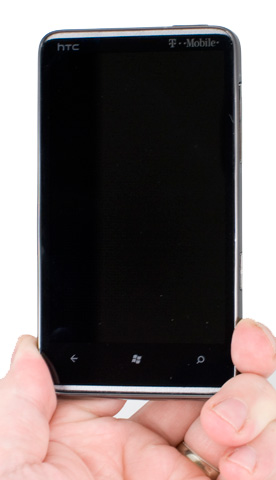
The HTC HD7 offers Windows Phone 7 in an extra-large package. With a huge, 4.3-inch screen and a kickstand to hold it up, the HD7 still follows the same formula as the other new WP7 phones. Is Microsoft's new mobile OS even more enjoyable living large, or should you stick with something smaller?
Body
The HTC HD7 is nearly identical in size and shape to the HTC HD2, though a closer look will reveal distinct changes in the style and materials. The front of the phone is dominated by the 4.3-inch display. At the very top and bottom of the front face are two speaker grills, so when the phone is propped up sideways on its kickstand, those speakers act as left and right channels for stereo. Beneath the screen the HD7 has the required Windows Phone 7 buttons: Back, Start and Search, always in that order. These are capacitive buttons, and between the speakers, the screen and buttons are part of one long, seamless piece of glass.
The HTC HD7 is more of a wide trapezoid shape than a regular rectangle. In some ways this is good thing, as the gently curved back and inward sloping sides make the phone relatively comfortable in the hand, considering it's probably the biggest phone you've ever seen. But those angled sides also make the side buttons more difficult to use. It was tough to find the thin sliver of the volume key. It was also difficult to hold a steady hand and press the camera button all the way down. I could never find the right grip.
Up top, you can see the power button / screen lock, but you can hardly feel it beneath your finger. You just have to press in that general area, and usually the screen lights up, unless you miss.
Around back, the top two-thirds of the back cover peels off to reveal the battery. On my review unit, the cover came off easily, but when I put it back on it left a little gap between the top and bottom parts. It wasn't a big deal, it just looked kind of ugly. The kickstand, on the other hand, is awesome. It surrounds the camera and the dual LED flash, and has a cool, industrial look when you snap it open, thanks to the holes for the lens and lights. With the kickstand open, the phone sits nicely on a desk in landscape position, tilted so it was easiest to see when I was two or three feet away. Around back you'll also find an extra speaker for the speakerphone.
There are heavier phones on the market, but not many. The HTC HD7 is a hefty phone, though it's Android cousin, the Sprint Evo 4G, is a quarter ounce heavier. Still, 5.7 ounces is not unreasonable, and the slim design with the rounded back make it easy to pocket in a well fitting pair of pants, though you'll want to wear a belt.
The Three S's
Screen
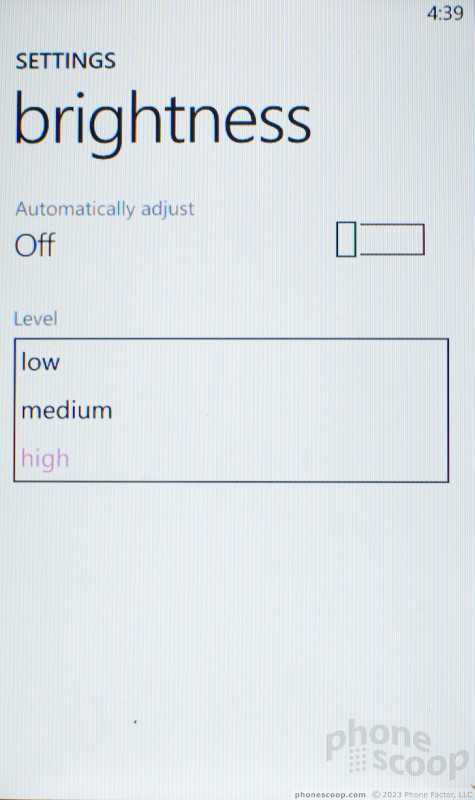
Whether or not you think you need a screen as large as the 4.3-inch LCD display on the HTC HD7, it's hard not to smile when the phone lights up. The display is big, but it's also very sharp, and pictures and text look fantastic. Windows Phone 7's interface brings out the best in this display. The screen is 800 x 480 pixels, the same as all the other WP7 devices, but it doesn't seem blown up or pixelated. Outdoors, the screen is destroyed by bright sunlight. It was very difficult to see the HD7's interface or camera viewfinder with the sun shining bright. It wasn't invisible, but I had to squint or shade the phone with my hand.
Sound
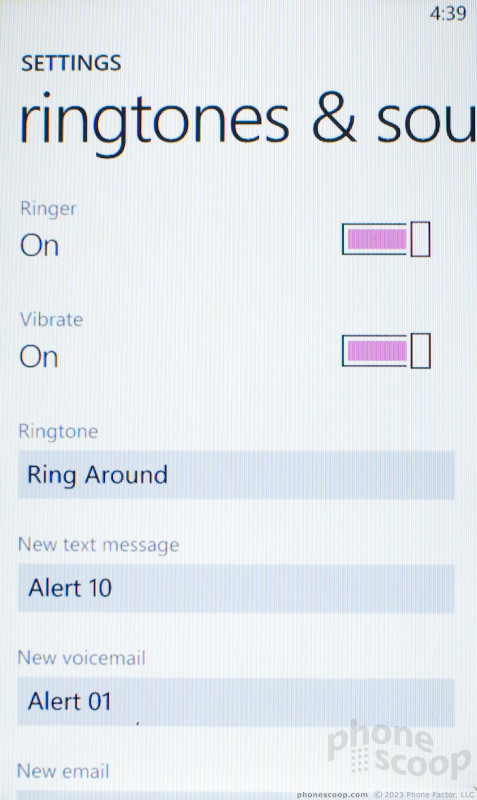
Sound quality on the HTC HD7 was good, but it could have been better. The earpiece could get plenty loud, but voices sometimes had a static and a digital humming quality to them. On their end, my callers reported more sound problems, a fuzziness that occasionally forced me to repeat myself. It wasn't fatal, but I've heard much better.
The stereo speakers on the HTC HD7 are a huge letdown. I was hoping for enough volume to be able to watch a video on the phone without needing to use my earbuds. But I could hardly hear the dialogue with the phone held near my head, let alone sitting three feet away on a desk. I tested the phone with Netflix videos and my own MP4 video files. At best, the sound was audible but fuzzy. At worst, the speakers seemed useless. HTC offers a sound enhancement app as a free download, which offers so-called Dolby Mobile and SRS Enhancement options, but neither of these improved the sound, they simply widened the stereo effect and changed the tone a bit. Perhaps HTC was worried about cannibalizing sales of the HTC Surround, which has a set of slide-out speakers?
Signal
Signal strength on the HTC HD7 also needs improvement. The phone dropped my network connection a few times, both my Wi-Fi signal and the T-Mobile network signal. This caused some interruptions in streaming video playback over Netflix, and I lost a couple calls in my test period, as well. Usually the phone held a solid three bars of service, which always meant I had a steady network connection for Web browsing and email. But it could be unreliable.
Battery
Battery life on the HTC HD7 was okay, but the phone won't win any awards for longevity. I pulled the phone away from the charger just before work at 8:30 AM, and by 6 PM I was getting power warning. With some frugal usage, hitting the camera or the GPS a little less, I could get through a full day, but this phone will need to be charged every night, or you'll wake up with a useless slab of HTC drywall on your bedside table in the morning.
Touch
Touch response on the HTC HD7 was very sensitive. Maybe too sensitive. I ran into an interesting conundrum with the large phone and the Windows Phone 7 interface. Windows Phone 7 uses swiping extensively. You're always moving the screens left and right, and the next screen usually overhangs a little bit so you can see what's there. The HD7 is so large that my thumb did not have room to arc up and away from the device before coming down again to touch the screen. Thus, if I wanted to tap something in the middle of the phone with only one hand, the pad of my palm often brushed the side of the display and the phone registered a swiping motion, taking me to the next screen. I'm not sure how HTC could overcome this problem on Windows Phone 7. One-handed use just might be out of the question on such a large device. Still, I'd much rather have a phone with touch response that was too sensitive than a phone that couldn't register my swipes.
Basics
Menus
We've already covered the Windows Phone 7 interface design extensively in our reviews of the Samsung Focus and the HTC Surround, so I won't rehash everything here. Instead I'll focus on how the large screen and unique HTC features on the HTC HD7 affect Microsoft's new OS.
Windows Phone 7 leaves a lot of empty space on the screen. Unlike other smartphone systems like Apple's iOS or Google's Android, which allow you to fill your screen from edge to edge with app icons, shortcuts and the like, Windows Phone 7 uses empty space to help focus the user on a few key details. I think it works nicely. There is a feeling of breezy simplicity to the Windows Phone 7 interface, and the large empty spaces, combined with the big tiles that are fields of solid color with a monochrome icon and text stamped on them, make the interface seem simple and approachable, while the multiple layers of animation tell you that it's modern and powerful. If this design works on any phone, it works on the HD7.
Another benefit of the larger screen size is the larger button size in the interface. Windows Phone 7 unfortunately relies on many tiny, circular buttons that pop up at the bottom of the screen in almost every app. Even on a phone like the Samsung Focus, which uses a 4-inch display, these buttons can be difficult to decipher because they are so small. I still wish they were bigger, but the HTC HD7 gives you the best shot at distinguishing them.
Obviously the HD7's size also increases the size of the onscreen keyboard, which does make typing a little easier. Still, this makes the landscape keyboard, which does not stretch from end to end on the screen, seem even more stingy.
One flaw in Windows Phone 7 is its lack of shortcuts. Like with Apple's iPhone, changing basic settings on Windows Phone 7 requires multiple taps and swipes. From the home screen, for instance, changing the brightness level on the display takes five or six taps and swipes. On an Android device, it takes one or two. Turning on Wi-Fi or changing the device theme takes a similar number of steps. While Microsoft lets you place a variety of items on the main column of tiles, these system settings, which I need to access far more often than I'll use the Microsoft Marketplace, for instance, are much less accessible. These are also the sort of actions I'll perform one-handed, and the HD7 does make one-handed use a bit more tricky.
There is one benefit of the huge screen size that I hadn't considered until recently. My 60-year-old mother, who has worn glasses for most of her life, loves the huge screen size. The size and heft of the device doesn't bother her, and the extra large screen makes it much easier to dial numbers, read text on the Internet and show off pictures of her grandchild.
Calls / Contacts
Calling features on the HTC HD7 are nearly identical to the other Windows Phone 7 devices, though HTC has added a few cool features that are holdovers from previous Windows Mobile devices. In the HTC Hub (every manufacturer gets their own Hub, a sort of mini app store), HTC offers the Attentive Phone app. Attentive phone gives you some very cool additions to the phone features.
You can set the phone to hush the ringer when you pick it up. After all, once you have it in hand, it doesn't need to ring so loudly. You can also set the phone to ring louder when it is in your pocket.
My favorite is the flip for speaker feature. Just as it sounds, when you flip the device over and place it face down on a desk, the HD7 will activate the speakerphone. This is such a thoughtful, intuitive action, I loved having it, especially in the car when I could simply answer the phone and place it face down on the seat next to me so I could talk with the speaker and keep my hands free. No fumbling for buttons, which is nice because Windows Phone 7 hides the speaker, mute and hold options in a drop down menu on the in-call screens.
These features are not new to long-time HTC fans, but they are unique among the current crop of Windows Phone 7 devices, which gives the HD7 an advantage in calling over the Samsung Focus or other competing devices.
Calling and contacts features also benefit from the large screen on the HD7. When you make a call from the call logs, you have to press a tiny phone button next to the name to initiate the call. If you tap the name itself, you get that person's address book entry. Having larger buttons makes it easier to hit the right target.
Also, contact photos look great in Windows Phone 7, and the larger they are the better. The phone synchronizes with Facebook to populate your contact list with your friends' Facebook avatars, and you can then pin the contact to your Start screen. You can see their big, smiling faces even larger on the HD7.
Messaging
The extra screen real estate definitely makes for a larger keyboard on the HTC HD7, but I'm still not sold on Microsoft's keyboard design. It looks very plain, which is in keeping with the overall simplicity of the interface, but I wish the keyboard had more to offer. For instance, on many other smartphone platforms, holding down a letter key gives you the corresponding symbol, so you don't need to tap the Alt key (the “&123” key on WP7) to choose a symbol. On the Windows Phones, you can only see the letters, though the keyboard also offers a key for @ and one for “.com”. Here's a pro tip for any Windows Phone 7: you can tap and hold your finger down on the “&123” key, then when the symbols pop up, slide to the symbol you need. The keyboard will type the symbol, then revert back to the QWERTY alphabet when you lift your finger.
Messaging features are identical on the HD7 to the other Windows Phone 7 devices. There is support for Exchange, POP and IMAP accounts, and the phone keeps your email inboxes separate. More casual users might wish for a unified inbox that groups everything together, but business users will prefer the WP7 design, which keeps your work and personal email separate.
One flaw that still bothered me on Windows Phone 7 is the inability to send a text message to any number in your address book. If you type someone's name into the SMS recipient field, the phone only offers you numbers that are labeled “mobile.” Sure, you could spend a long time fixing your address book. Some users might even find this more convenient, since it eliminates extraneous numbers from the available choices. But my work number is a mobile, and the same is true for a lot of people I know. I'd like to have more options, at least.
Work/Life Balance
Social Networking
The HTC HD7 integrates tightly with Facebook, but the experience feels incomplete. The phone automatically synchronizes your Facebook contacts with your address book. There's no way to keep the two separate, and the phone does not support groups for contacts, which is especially odd because even the cheapest feature phones let you group your contacts.
Though the phone doesn't come preloaded with official Twitter and Facebook apps, these apps are available free from the Windows Phone 7 Marketplace. They look very good, in keeping with the rest of the WP7 design. The HD7 has a problem with scrolling, though, and this was most apparent in the social networking apps. When I tried to flick quickly through my Twitter feed, or through all of my friends' updates in Facebook, the list would jump around wildly and occasionally take me back to my original point. Slow scrolling worked fine, but who wants to scroll slowly through a hundred Twitter posts?
Productivity
While I had problems with the Office suite when I tested the Samsung Focus, the HTC HD7 had no such issues. All of my test documents for Word, PowerPoint and Excel came through just fine, and the phone had no trouble opening any of them. Editing PowerPoint slides requires the newest version of Office, which I don't have, but the slides looked great on the HD7's screen, accurate and clear. It was also easy to browse through multiple pages in my Excel spreadsheet and flip through sections of my PowerPoint deck.
Word is the odd man out. My Word document came through fine, and I was able to edit and add text. But the mobile version of Word does not stick to perfect formatting, so your document will be scaled to fit the phone's small screen. If layout is important to you and you want to see how a document will look when printed, Word in WP7 won't help you. But everything else worked fine, including tables and lists.
Extras
Multimedia
The multimedia experience on Windows Phone 7 is mostly great, especially if you stick with the Zune player. I had no trouble synchronizing my music from my iTunes library on my Mac with the HD7, using the beta version of Microsoft's Windows Phone 7 connector. The software even did a fine job transferring photos and MP4 videos from my collection. The photo albums from iPhoto did not show up properly, though, leaving photos grouped by date, which wasn't a big issue. Also, the software had to convert my video to a usable format, which took forever, but after the conversion my video looked fantastic on the HD7's screen.
The HD7 comes with 16GB of internal memory. There is no memory card expansion available for users, unlike the Samsung Focus which offers a more difficult one-time microSD card update process. I think 16GB will be plenty for most users, and synchronizing media to swap out music and videos was no trouble, just a little time consuming.
I had trouble with the extra multimedia software T-Mobile and HTC bundle with the HD7. The Netflix app is very impressive, with a solid interface an robust features for Netflix subscribers. But playback gave me trouble. First, I had numerous error messages telling me Netflix was being stopped by my network. Then, it would start working again with no change from me. Second, video quality could be very poor, even when I was connected to Wi-Fi. Usually the quality was great, and very watchable. But sometimes videos were so compressed that they looked as if they had been created using Lego bricks and stop motion photography.
T-Mobile has also launched its own streaming video service, similar to the streaming service available from the other 3 big nationwide carriers. These are always a dull mix of short video clips, not worth the time or data wasted on viewing them. Though the service claims to offer full episodes of some shows, the selection was incredibly sparse, and the 'full episodes' were nothing more than a group of clips bunched together. So, you have to watch the show in 5 minute blocks. Worst of all, though, is that I couldn't get the player to actually show me video. I could browse the selection and see the interface, but the player always reported errors and videos would not stream. That's probably for the best.
Camera
Camera
The camera button is one of my favorite features on the new Windows Phones. It's unusual to find a dedicated camera button on touchscreen phones, so I'm glad Microsoft mandated it. Whenever you want to take a picture, no matter what you're doing, you just press the button and the camera app fires up. If the screen is off, the camera will still wake up the phone. If you're browsing the Web or editing a spreadsheet, the button will still open the camera. No other smartphone platform treats the camera like a first class citizen, and WP7 makes for much faster shooting if you see a subject you want to snap in a hurry.
Unlike the Samsung Focus, which offers more advanced controls that experienced photographers might appreciate, the HTC HD7 offers options to help automate the shooting process. The camera app includes scene modes, which will tweak the settings for sports shots, backlit photos and macros, among other scenes. You can adjust the light metering mode, but that's it for camera controls. There is no white balance or other exposure controls in the camera app.
The camera app can also be set to automatically upload pictures. You can upload either to Microsoft's SkyDrive site, or upload to Facebook.
The HD7 uses two LED lamps for an incredibly bright flash. I mean painfully bright. Your subjects will be seeing spots for a few minutes after, but at least you'll have a well-lit shot. HTC also offers a flashlight app with three brightness levels so you can use the LEDs as a torch.
Image Gallery
The HTC HD7 offers three different ways to view your pictures, but the process is very intuitive so this wasn't too confusing. First, when you take a picture, instead of making you review it for a few seconds, your shot moves to the left of the screen and overhangs a bit onto the viewfinder display. If you swipe left to right, you can see the photo you just took, then swipe back to keep shooting. From this view, you can also upload your pics to Facebook or SkyDrive, or you can send them as email or MMS messages.
Then there is the Photo Enhancer, which is an HTC app from the HTC Hub. The Photo Enhancer offers automatic image enhancement, which brings out more of the dynamic range in your pictures and tweaks the color a bit. My photos did look a little better after some enhancement, especially if colors were weak or details lost in shadow. The Photo Enhancer also offers Vignette and Antique filter, among others, and these create the sort of polaroid or old school look that has become popular among the hipster set.
Finally, there is the Pictures Hub. The Hub lets you view your photos as a thumbnail set or individually. In addition to the photos you've taken with the camera and photos that you've sideloaded from your PC, you can also browse galleries that you've uploaded to Facebook or SkyDrive. Strangely, there is no slideshow option. With its kickstand and huge screen, the HD7 would make an excellent digital photo frame, so hopefully third party developers will fill in this gap.
Image Quality
Photos
Photos from the 5-megapixel camera on the HTC HD7 were pretty good. I got some great shots out of the camera, but some were pretty messy, and a few failed completely. Under bright outdoor light, pictures looked very good. Images had a nice depth of field and details were solid, as long as I didn't zoom in too close while reviewing them on my monitor. The camera oversaturates reds, like many small imaging sensors, so my pictures of the red flowers look like a blob of jelly with almost no detail.
I was disappointed with the camera's macro capabilities. I wanted to get much closer to my subjects, but my macro shots always came out blurry. Even indoors with the bright flash, the camera was not able to pick up sharp details up close.
Indoors, pictures in general looked blurry. A few shots, though, have me worried. Some of my indoor shots came out with a dramatic pink coloration. I could see this issue on the viewfinder as well, as I note in my video sample below. The HTC HD2 has similar problems at launch, but the issue was fixed in a later firmware update. Hopefully this is not a chronic problem with the HD7.
Video
Video quality from the HD7 seemed even better than the still image quality. The high-def, 720p video I shot with the camcorder looked great, among the best I've seen on a phone. It wasn't flawless. The camera adjusts the focus while you're shooting video, but it did not always adjust in time, and I ended up with long stretches of blur. Still, when the view is sharp, the video looks great.
Browse / Customize
Browse
The version of Internet Explorer on the HTC HD7 finally brings Microsoft devices into the modern age of mobile browsing. Pages look completely accurate on the Web browser. Every page I tried offered a full desktop version, so you won't have to suffer through the mobile versions of CNN, New York Times or whatever your favorite site may be. I had a little trouble with Google Reader, as the browser would get caught scrolling through the frames in my RSS feed. This was not the same as the buggy scrolling problems I had with the social networking apps, it was just a browser layout issue.
Navigating through pages was a breeze on the HD7. The screen is perfect for reading Web sites. The Web browser responded very quickly as I flicked up and down a page, and the pinch-to-zoom feature was incredibly smooth. I'd like to see Flash support in the future, but that's still a rarity on smartphones.
Customize
Windows Phone 7 doesn't allow customization so much as it allows you to organize your stuff. The Start screen tiles can be rearranged however you like, and every tile can be removed from the Start column. That column can get pretty long as you start adding Web pages, contacts and Bing Maps, but the tiles are big enough that you can scroll through them in a hurry.
You can adjust the theme of WP7 as well. The background can be black or white (a very light grey, really), and you can change the color of the main Start tiles and other interface bits. There are 10 colors to choose from, including some striking and some more staid choices. I'd like to have a color picker so that I can choose my own favorite color.
Extras
Bluetooth
I had no trouble pairing the HD7 with my Bluetooth headset and stereo speakers. The headset sounded pretty good, without any more noise than I'd expect from a Bluetooth earpiece. The speakers sounded even better. The HD7 cannot pair with a PC for object transfers, so you won't be able to send pictures or files back and forth from the phone, at least not wirelessly.
Clock
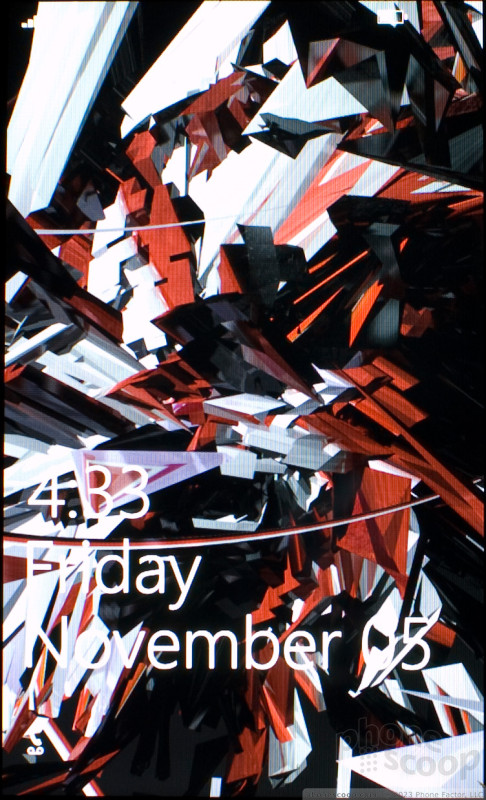
The lock screen on the HTC HD7 has a nice, big clock on it, along with the date and plenty of incoming call and message notification options. Once you've unlocked the screen, all you get is a miniscule clock in the notification bar up top. It's tiny, even on the giant HD7 screen. That clock persists through many apps but not all of them, so you won't be able to check the time on the HD7 without hitting the Start button or locking then unlocking the screen.
GPS
GPS navigation on the HD7 gave me a surprising amount of trouble. I used TeleNav, which is included with the phone. While I had a fine experience using TeleNav on the Samsung Focus, it was much less reliable on the HD7. The phone claimed I was off course a few times during my test run, even though I was traveling on a long, straight stretch of highway. Searching for local points of interest was a complete bust. Looking for a specific coffee shop, the phone first took me to a location in the middle of an open field. No coffee shop there, now or ever. When I tried to get directions to where I knew the shop to be, the POI database did not have it listed.
Bing maps wasn't much better. Bing does not offer turn by turn navigation, and TeleNav can't tie into your contact list. It's like having chocolate and peanut butter without mixing them together. When I searched Bing using the term “Paradise” to find my local Paradise Coffee chain, the map instead took me to Paradise, Nevada. How useless.
Gaming
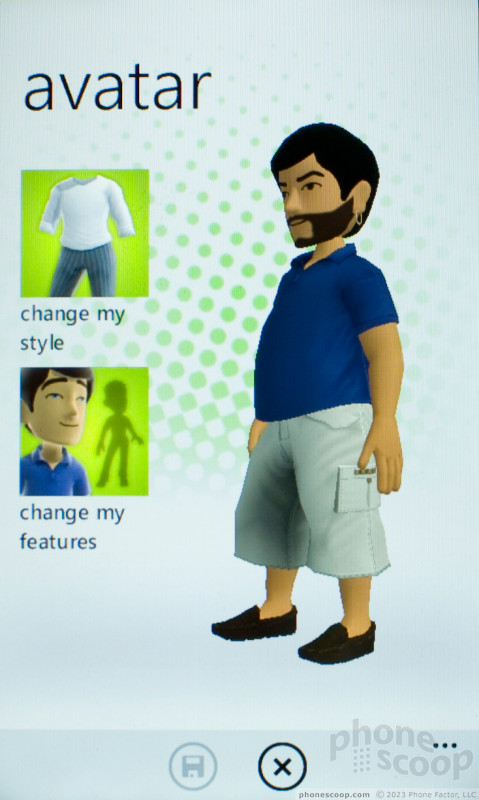
Even before the phone has launched in the U.S., Microsoft has built up an impressive store of Xbox Live games for Windows Phone 7. The new OS has leapfrogged almost all of the competition except Apple's iPhone platform, including Android devices, which offer very few high-quality games. There are some fun games available for WP7, including fast action games and board games. Graphics look good and the phone handles the touchscreen and accelerometer controls as well as the iPhone can. I'd like to see Microsoft leverage some of its best first-party titles (Halo, please?), but the selection is already impressive.
Video Tour
Wrap-Up
The HTC HD7 is a very nice device, and it handles Microsoft's new mobile OS well. The large screen made for a great multimedia, Web browsing and working experience, though I still think some aspects, like the onscreen keyboard, could use some improvement. There were also some kinks that need to be worked out, like the scrolling problems I had in some third-party apps, or the camera trouble that ruined a few shots.
The real question is how the HD7 stands up to the Samsung Focus, its closest competitor. The HD7 offers a larger screen and better overall materials, with metal accents and a body that feels rock solid. But the Samsung Focus is a bit smaller, making it more easy to use one-handed, and much lighter, by more than an ounce and a half. I also prefer Samsung's super AMOLED display to the big LCD on the HD7. The HD7 has better video recording, and my best HD7 pics beat my Samsung Focus samples, but the HD7's camera is less consistent.
If you're a T-Mobile fan, I have no problem recommending the HTC HD7. Like I said, it will make you smile every time you turn it on, and Microsoft's elegant interface looks wonderful spread out across the HD7's face. But if you have some leeway in your carrier choice, I would take a look at the Focus as well before you make a final decision.
Comments
At Least This Phone has the right idea
Even a basic quick messaging phone will have a microSD slot for removeable memory expansion. It makes more sense (from a one-time memory update standpoint) to just have no memory expansion and put the extra GB's in the phone itself. Even from a marketing view ... this phone seems like a better idea.
This seems like the Cherry of t...
(continues)


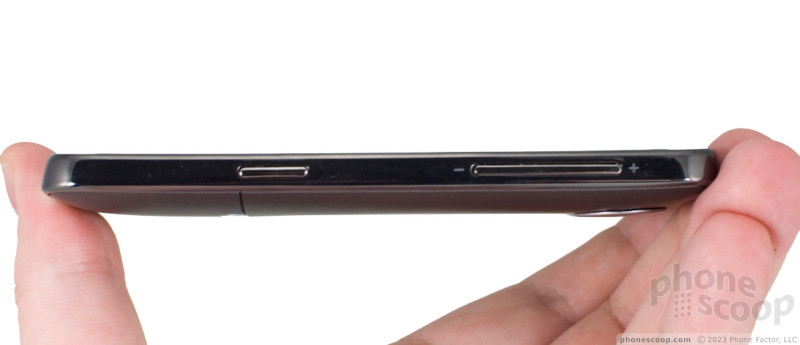







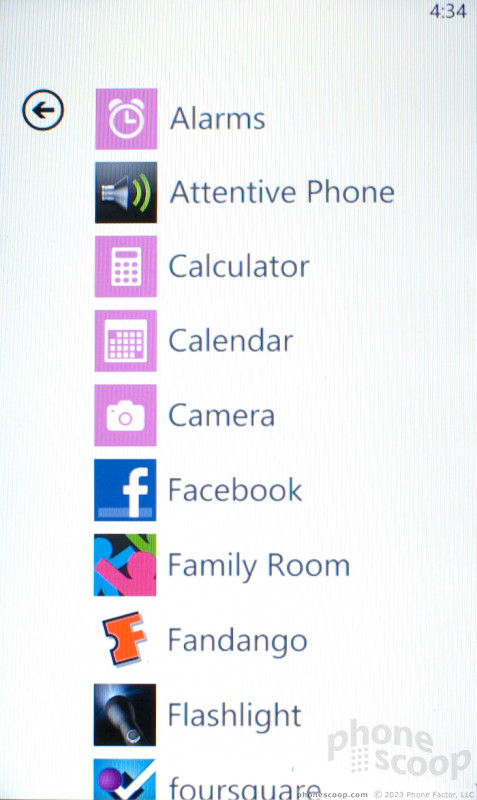






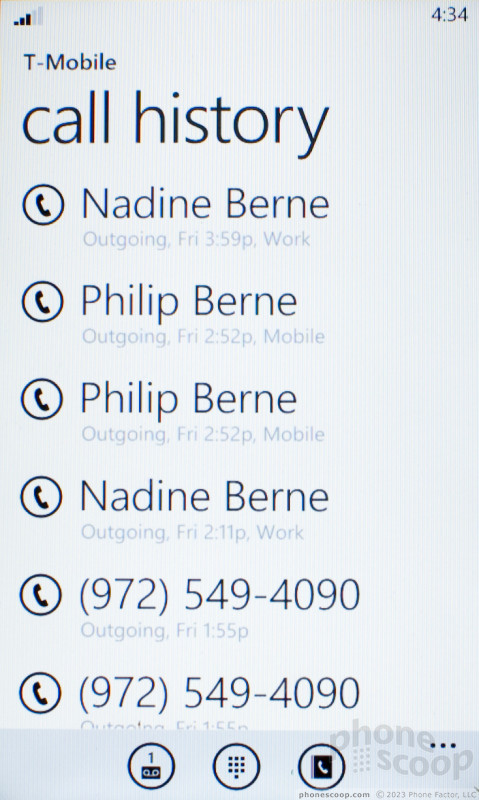




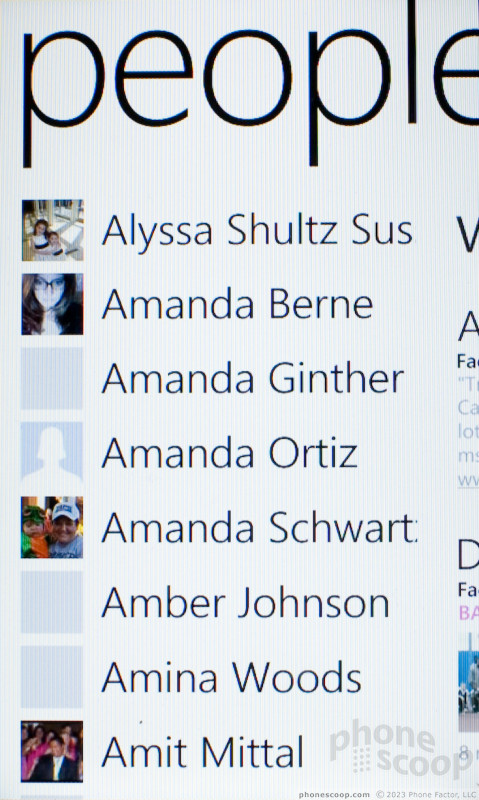



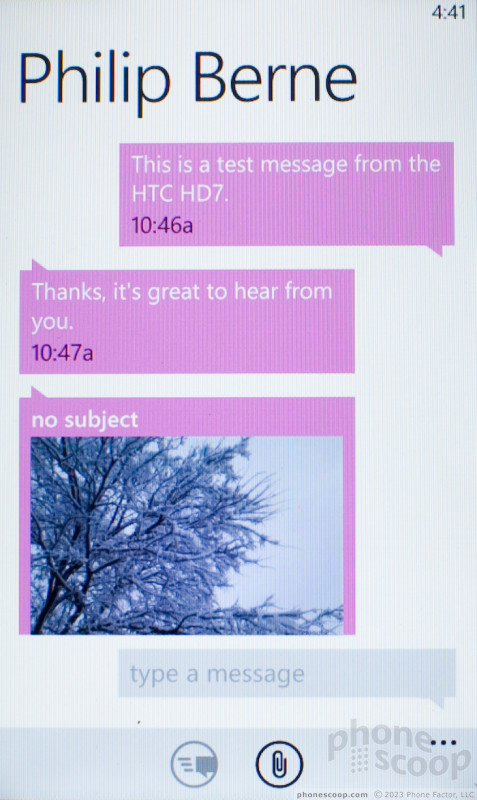




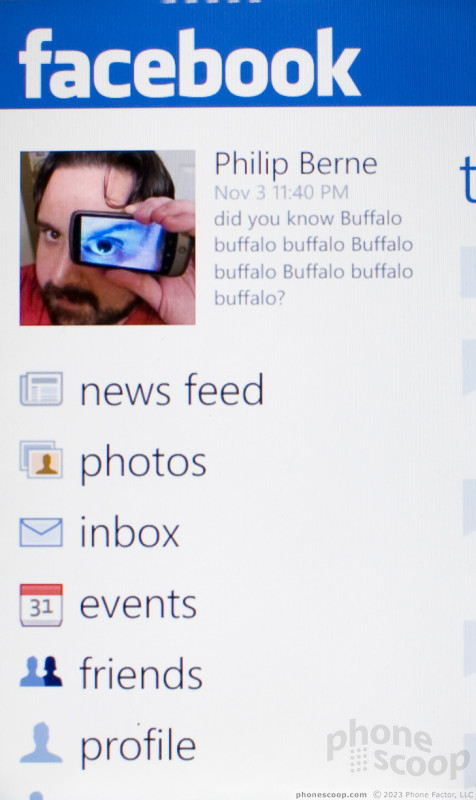



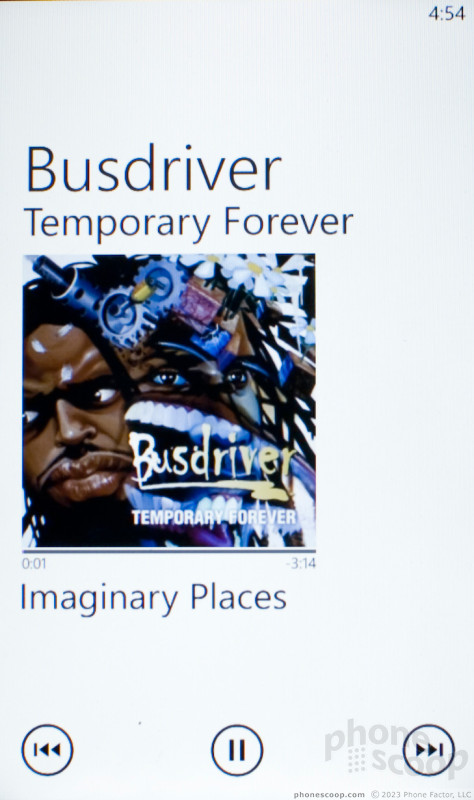


















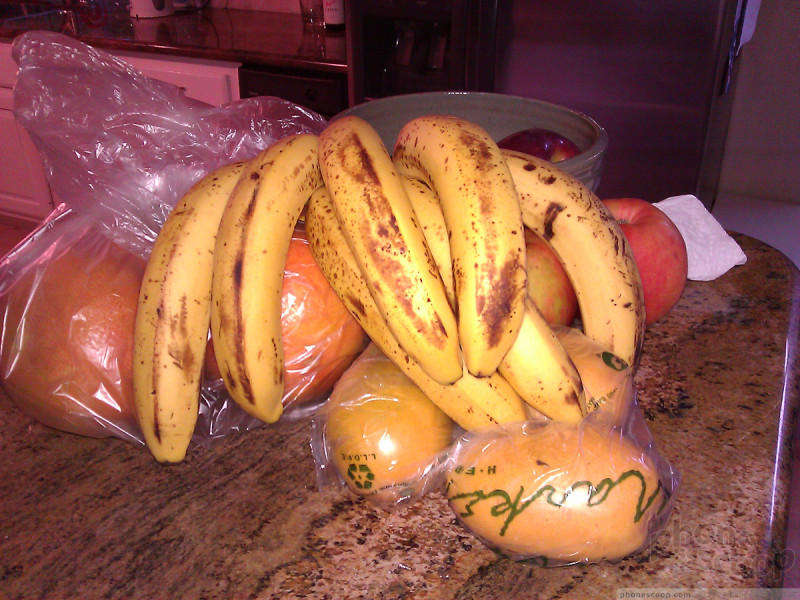










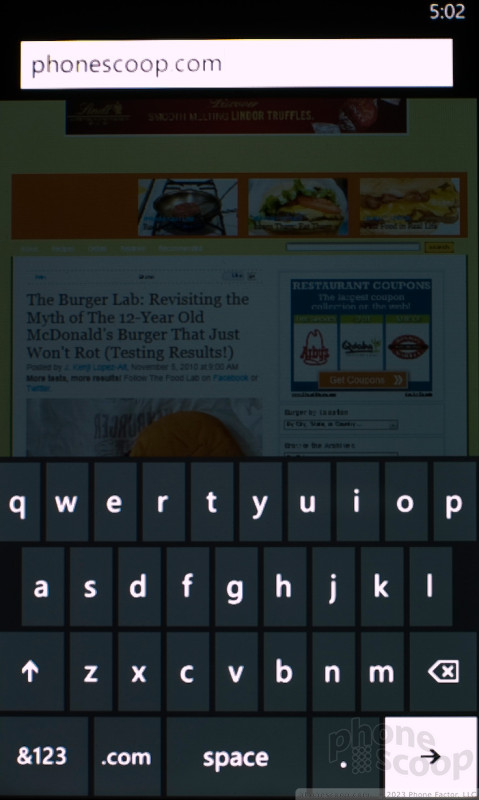





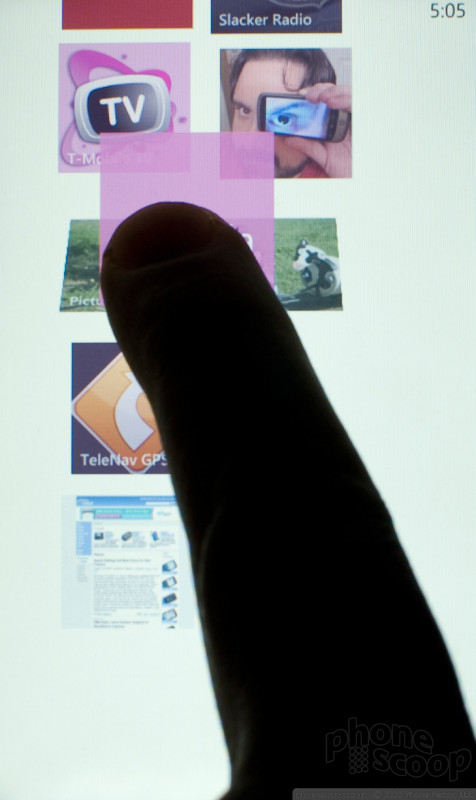



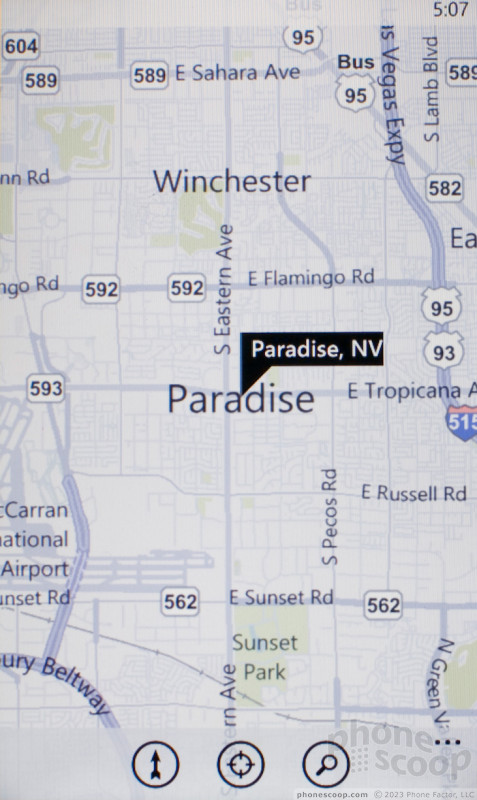




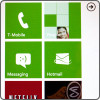 Windows Phone 7: Hands-On
Windows Phone 7: Hands-On
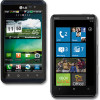 Optimus 3D, HD7 Come To AT&T
Optimus 3D, HD7 Come To AT&T
 HTC HD7 / HD7S
HTC HD7 / HD7S



